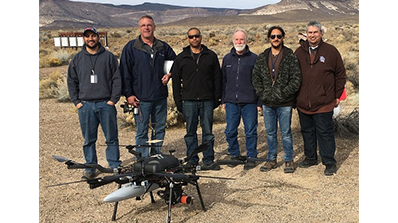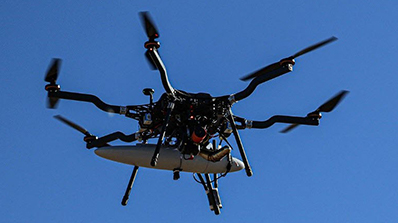In December 2019, a team led by scientists from the Nevada National Security Site (NNSS) Special Technologies Laboratory and Remote Sensing Laboratory-Nellis demonstrated a radiation detection, measurement and mapping mission using a small unmanned aircraft system (sUAS). Using a sUAS equipped with a high-efficiency radiation detector, the team successfully performed radiation scans over two Yucca Flat test locations and successfully demonstrated how UAS technology can be leveraged in support of national security and public health and safety missions, particularly in the area of emergency response and consequence management. The flyover mission was sponsored by the Site-Directed Research and Development UAS initiative and led by Rusty Trainham, a senior principal scientist from the NNSS Special Technologies Laboratory, and Paul Guss, a distinguished scientist from the NNSS Remote Sensing Laboratory-Nellis.
A sUAS can be used in conjunction with existing capabilities from manned aircraft to provide more detailed follow-on surveys of radiation and contamination following a radiological emergency. The team is planning more field work to further explore the ability of a sUAS to fly into and assess difficult areas, such as tunnels and other GPS-denied environments, during national emergency situations. Additionally, the team is moving closer to achieving their goal of developing hardware, methods and expertise to provide critical information that helps protect emergency responders and the public in the event of a radiological emergency.

Aerial radiological surveys have been conducted at the NNSS since the 1960s; what was unusual about this mission was that the team conducted aerial radiological surveys using a sUAS, commonly known as a drone, and a lightweight yet sturdy radiation detector. The use of unmanned aircraft can augment existing aerial radiation detection capabilities because an unmanned aircraft can fly much lower and slower than a manned aircraft, enabling the team to collect more detailed radiation measurements and geographical information. A sUAS can also maneuver into an area that would be unthinkable for a manned aircraft to access and collect data.
The gamma imager was attached to the hexacopter and flown over the Sedan and Baneberry nuclear test craters. (The Sedan test was conducted on July 6, 1962, and the Baneberry test took place on December 18, 1970.) The gamma imager weighs about 10 pounds, and it fits into a volume of 18 by 3 by 4 inches. The hexacopter is about the size of a card table, and the gross weight is about 50 pounds with the payload and fuel. At sea level, it can fly for up to two hours at a time, but at the altitude of the NNSS, the time is limited to approximately 30 to 40 minutes. The sUAS flew over a distance of a few kilometers to complete the surveys. Data collected during the surveys demonstrated that greater sensitivity and geographical resolution can be achieved with UAS technology.
In early 2020, the team revisited the Sedan and Baneberry craters to obtain more measurements. During this visit, the team also traveled to the Palanquin nuclear test crater (the Palanquin test took place on April 14, 1965) to collect additional survey and imaging data. Watch the small UAS in action in this YouTube video.

